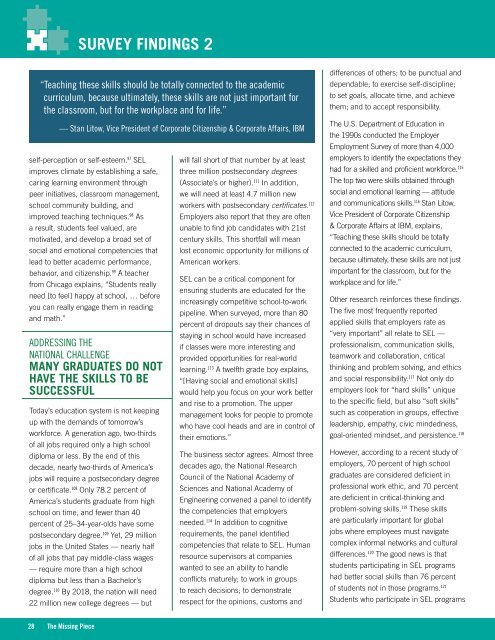CASEL-Report-low-res-FINAL
CASEL-Report-low-res-FINAL
CASEL-Report-low-res-FINAL
You also want an ePaper? Increase the reach of your titles
YUMPU automatically turns print PDFs into web optimized ePapers that Google loves.
28 the Missing Piece<br />
Survey FindingS 2<br />
“Teaching these skills should be totally connected to the academic<br />
curriculum, because ultimately, these skills are not just important for<br />
the classroom, but for the workplace and for life.”<br />
— Stan Litow, Vice P<strong>res</strong>ident of Corporate Citizenship & Corporate Affairs, IBM<br />
self-perception or self-esteem. 97 SEL<br />
improves climate by establishing a safe,<br />
caring learning environment through<br />
peer initiatives, classroom management,<br />
school community building, and<br />
improved teaching techniques. 98 As<br />
a <strong>res</strong>ult, students feel valued, are<br />
motivated, and develop a broad set of<br />
social and emotional competencies that<br />
lead to better academic performance,<br />
behavior, and citizenship. 99 A teacher<br />
from Chicago explains, “Students really<br />
need [to feel] happy at school, … before<br />
you can really engage them in reading<br />
and math.”<br />
ADDRESSING THE<br />
NATIoNAL CHALLENGE<br />
MANy gRAduATES do NoT<br />
HAvE THE SkiLLS To bE<br />
SuCCESSfuL<br />
Today’s education system is not keeping<br />
up with the demands of tomorrow’s<br />
workforce. A generation ago, two-thirds<br />
of all jobs required only a high school<br />
diploma or less. By the end of this<br />
decade, nearly two-thirds of America’s<br />
jobs will require a postsecondary degree<br />
or certificate. 108 Only 78.2 percent of<br />
America’s students graduate from high<br />
school on time, and fewer than 40<br />
percent of 25–34-year-olds have some<br />
postsecondary degree. 109 Yet, 29 million<br />
jobs in the United States — nearly half<br />
of all jobs that pay middle-class wages<br />
— require more than a high school<br />
diploma but less than a Bachelor’s<br />
degree. 110 By 2018, the nation will need<br />
22 million new college degrees — but<br />
will fall short of that number by at least<br />
three million postsecondary degrees<br />
(Associate’s or higher). 111 In addition,<br />
we will need at least 4.7 million new<br />
workers with postsecondary certificates. 112<br />
Employers also report that they are often<br />
unable to find job candidates with 21st<br />
century skills. This shortfall will mean<br />
lost economic opportunity for millions of<br />
American workers.<br />
SEL can be a critical component for<br />
ensuring students are educated for the<br />
increasingly competitive school-to-work<br />
pipeline. When surveyed, more than 80<br />
percent of dropouts say their chances of<br />
staying in school would have increased<br />
if classes were more inte<strong>res</strong>ting and<br />
provided opportunities for real-world<br />
learning. 113 A twelfth grade boy explains,<br />
“[Having social and emotional skills]<br />
would help you focus on your work better<br />
and rise to a promotion. The upper<br />
management looks for people to promote<br />
who have cool heads and are in control of<br />
their emotions.”<br />
The business sector agrees. Almost three<br />
decades ago, the National Research<br />
Council of the National Academy of<br />
Sciences and National Academy of<br />
Engineering convened a panel to identify<br />
the competencies that employers<br />
needed. 114 In addition to cognitive<br />
requirements, the panel identified<br />
competencies that relate to SEL. Human<br />
<strong>res</strong>ource supervisors at companies<br />
wanted to see an ability to handle<br />
conflicts maturely; to work in groups<br />
to reach decisions; to demonstrate<br />
<strong>res</strong>pect for the opinions, customs and<br />
differences of others; to be punctual and<br />
dependable; to exercise self-discipline;<br />
to set goals, allocate time, and achieve<br />
them; and to accept <strong>res</strong>ponsibility.<br />
The U.S. Department of Education in<br />
the 1990s conducted the Employer<br />
Employment Survey of more than 4,000<br />
employers to identify the expectations they<br />
had for a skilled and proficient workforce. 115<br />
The top two were skills obtained through<br />
social and emotional learning — attitude<br />
and communications skills. 116 Stan Litow,<br />
Vice P<strong>res</strong>ident of Corporate Citizenship<br />
& Corporate Affairs at IBM, explains,<br />
“Teaching these skills should be totally<br />
connected to the academic curriculum,<br />
because ultimately, these skills are not just<br />
important for the classroom, but for the<br />
workplace and for life.”<br />
Other <strong>res</strong>earch reinforces these findings.<br />
The five most frequently reported<br />
applied skills that employers rate as<br />
“very important” all relate to SEL —<br />
professionalism, communication skills,<br />
teamwork and collaboration, critical<br />
thinking and problem solving, and ethics<br />
and social <strong>res</strong>ponsibility. 117 Not only do<br />
employers look for “hard skills” unique<br />
to the specific field, but also “soft skills”<br />
such as cooperation in groups, effective<br />
leadership, empathy, civic mindedness,<br />
goal-oriented mindset, and persistence. 118<br />
However, according to a recent study of<br />
employers, 70 percent of high school<br />
graduates are considered deficient in<br />
professional work ethic, and 70 percent<br />
are deficient in critical-thinking and<br />
problem-solving skills. 119 These skills<br />
are particularly important for global<br />
jobs where employees must navigate<br />
complex informal networks and cultural<br />
differences. 120 The good news is that<br />
students participating in SEL programs<br />
had better social skills than 76 percent<br />
of students not in those programs. 121<br />
Students who participate in SEL programs


